The application provides a powerful command for translating elements. You may either perform a simple translation (by moving elements) or create several copies of 2D elements.
This task shows you how to translate 2D elements by using the duplicate mode and then selecting the element to be duplicated.
-
Click Translation
 .
.
The Translation Definition dialog box appears. It will remain displayed all along your translation creation. The Duplicate mode option is activated by default, which means that the 2D elements you select will be copied. If you uncheck Duplicate mode, the element will be moved.
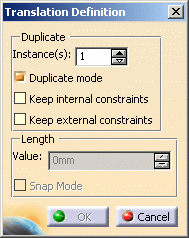
-
Keep the Instance(s) field to 1 and the Duplicate mode option activated.
-
Select the Keep internal constraints option.
This option specifies that you want to preserve in the translation the internal constraints applied to the selected elements. -
Keep the Keep external constraints 1 option deactivated.
Any external constraint existing between the selected elements and external elements will be disregarded in the translation. -
Select the elements to be translated using the trap selection.
You may either select one 2D element, or multi-select the entire 2D geometry by trapping it with the mouse as shown below.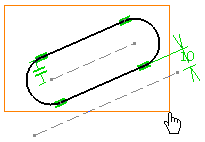
-
Click to indicate the translation vector starting point.
You can define the translation length in the geometry area, using the mouse. For more precise results, enter a specific value for the translation length in the Translation Definition dialog box.
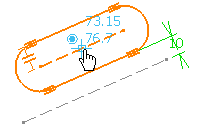
-
Type 30mm in the length field and press Enter.
You can use SmartPick to keep lines horizontal.
Optionally, you can select the Snap Mode option in the dialog box.
-
The translation length is incremented by steps of 5mm by default.
-
To change the default step value, right-click the Value combo and choose a predefined step value or define a new one.
-
Click to indicate the translation vector ending point.
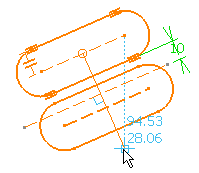
-
Click OK.
The translation has been performed.
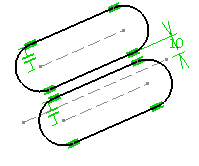
You can notice that the internal constraints were preserved in the translated element (four tangency constraints, and a parallelism constraint), whereas the external constraint (an offset constraint) was not.
-
The Undo
 command is available from the toolbar, while you are translating
elements.
command is available from the toolbar, while you are translating
elements. -
When translating external constraints:
-
geometrical constraints are deleted..
-
dimensional constraints are preserved but revalued.
-
More about the Translate Command
- When you are using Translation
 , the top priority is to ensure the
move of geometrical elements. This is the reason why some geometrical or dimensional constraints
may be removed or modified in order to assure the move of selected geometrical
elements
according to the given vector of translation.
, the top priority is to ensure the
move of geometrical elements. This is the reason why some geometrical or dimensional constraints
may be removed or modified in order to assure the move of selected geometrical
elements
according to the given vector of translation. - Translating elements also means re-computing distance, angle and/or length constraint values, if needed. Be careful: only non-fixed elements are updated.
- Multi-selection is not available.